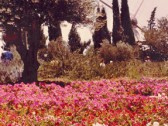About the project
The Bloomfield Garden, located just above and on either side of the Yemin Moshe neighborhood, is one of the largest parks in Jerusalem (approximately 17 acres). The municipality purchased the Nikephoria area in which the park is located from the Greek Orthodox Church in order to safeguard its preservation as public open space. The park’s design by Ulrik Plessner was intended to be an organic extension of the open spaces surrounding the Old City to the east. The garden incorporates the family tomb of King Herod and remains of an ancient aqueduct. The park includes lawns, play areas and a fountain. Benches, drinking fountains (including Gwendoline’s Fountain for dogs), bathrooms and flower beds have been added over the years. In 1996, the garden was renovated and the Israel Bonds Tribute Site, which includes a time capsule, was created at the park. Several works of art are located in the garden. Whirl, a play sculpture by Swedish sculptor Axel Nordell was placed in the park in 1979. Nordell conceived of the polished cast concrete sculpture that allows children to climb and slide within it during his stay at Mishkenot Sha’ananim. Four Cubes Cut in Identical Halves Which Make Eight Elements is a stone sculpture by Swiss painter and sculptor Max Bill (1908-1994) that was erected at the Bota Street entrance to the garden in 1985. The sculpture, which was created between 1973 and 1985, consists of eight geometric forms of precise proportions that are placed in relation to one another and visually can be stacked in pairs to form four identical cubes. Fountain of the Lions is a cast bronze water sculpture erected at the southern tip of Bloomfield Garden in 1989. The fountain was donated by then-Chancellor Helmut Kohl, to then-Mayor Teddy Kollek as a mark of the commitment of the Federal Republic of Germany to the City of Jerusalem. The fountain, which was designed by German Professor Gernot & Barbara Rumpf features a central tree of life atop which stands Noah’s dove and aro




















